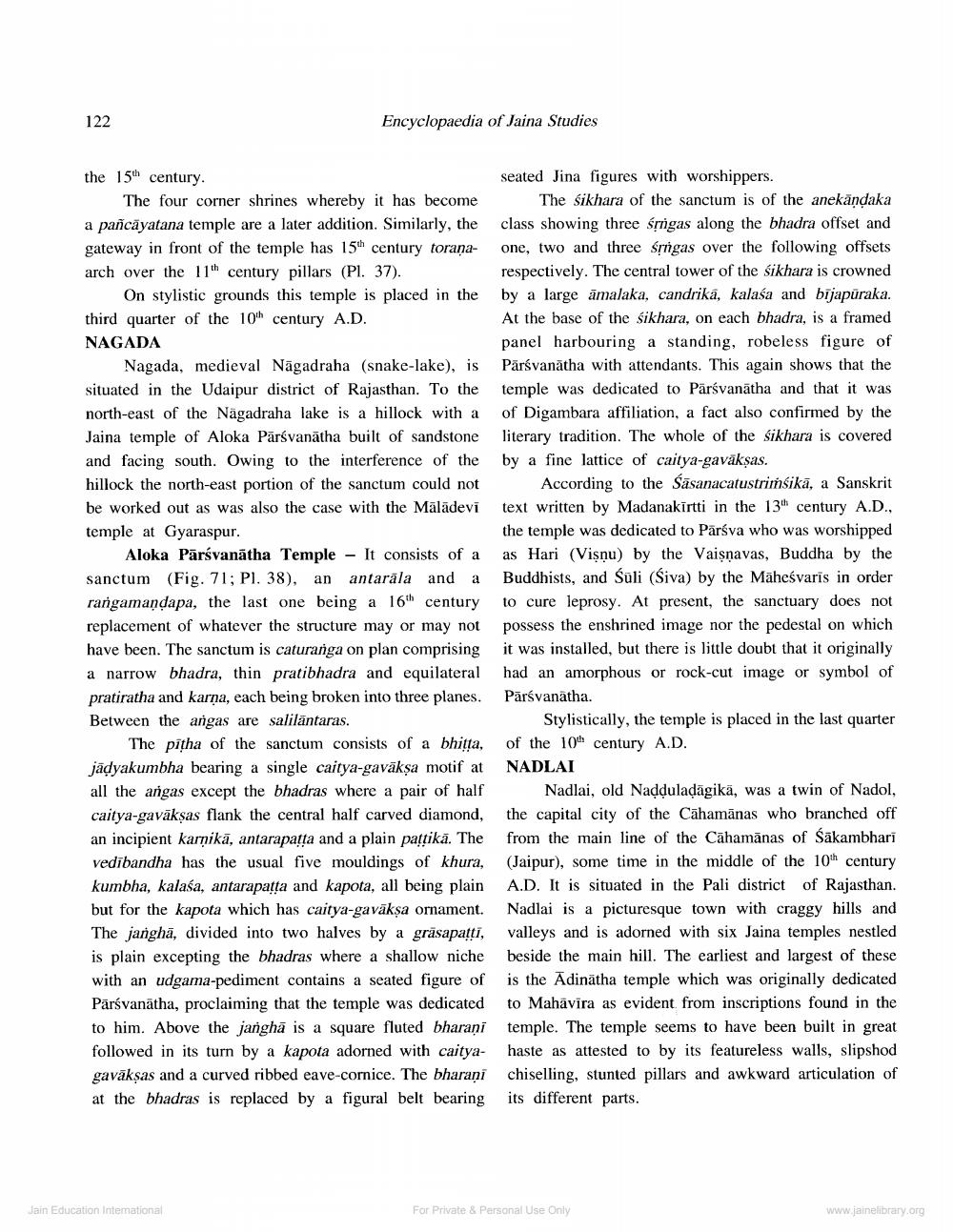________________
122
Encyclopaedia of Jaina Studies
the 15th century.
seated Jina figures with worshippers. The four corner shrines whereby it has become The sikhara of the sanctum is of the anekändaka a pancāyatana temple are a later addition. Similarly, the class showing three śmigas along the bhadra offset and gateway in front of the temple has 15th century torana- one, two and three śľngas over the following offsets arch over the 11th century pillars (Pl. 37).
respectively. The central tower of the sikhara is crowned On stylistic grounds this temple is placed in the by a large āmalaka, candrika, kalasa and bijapüraka. third quarter of the 10th century A.D.
At the base of the sikhara, on each bhadra, is a framed NAGADA
panel harbouring a standing, robeless figure of Nagada, medieval Nāgadraha (snake-lake), is Pārsvanātha with attendants. This again shows that the situated in the Udaipur district of Rajasthan. To the temple was dedicated to Pärśvanātha and that it was north-east of the Nägadraha lake is a hillock with a of Digambara affiliation, a fact also confirmed by the Jaina temple of Aloka Pārsvanātha built of sandstone literary tradition. The whole of the sikhara is covered and facing south. Owing to the interference of the by a fine lattice of caitya-gavākşas. hillock the north-east portion of the sanctum could not According to the Sāsanacatustrimsikā, a Sanskrit be worked out as was also the case with the Mālādevi text written by Madanakirtti in the 13th century A.D., temple at Gyaraspur.
the temple was dedicated to Pārśva who was worshipped Aloka Pārsvanātha Temple - It consists of a as Hari (Visnu) by the Vaisnavas, Buddha by the sanctum (Fig. 71; Pl. 38), an antarala and a Buddhists, and Sūli (Siva) by the Māheśvarīs in order rangamandapa, the last one being a 16th century to cure leprosy. At present, the sanctuary does not replacement of whatever the structure may or may not possess the enshrined image nor the pedestal on which have been. The sanctum is caturanga on plan comprising it was installed, but there is little doubt that it originally a narrow bhadra, thin pratibhadra and equilateral had an amorphous or rock-cut image or symbol of pratiratha and karna, each being broken into three planes. Pārsvanatha. Between the angas are saliläntaras.
Stylistically, the temple is placed in the last quarter The pitha of the sanctum consists of a bhitta, of the 10th century A.D. jadyakumbha bearing a single caitya-gavākṣa motif at NADLAI all the angas except the bhadras where a pair of half Nadlai, old Nadduladāgikā, was a twin of Nadol, caitya-gavākşas flank the central half carved diamond, the capital city of the Cāhamānas who branched off an incipient karnikā, antarapatta and a plain pattikā. The from the main line of the Cāhamānas of Sākambhari vedībandha has the usual five mouldings of khura, (Jaipur), some time in the middle of the 10th century kumbha, kalasa, antarapatta and kapota, all being plain A.D. It is situated in the Pali district of Rajasthan. but for the kapota which has caitya-gavākṣa ornament. Nadlai is a picturesque town with craggy hills and The janghā, divided into two halves by a grāsapatti, valleys and is adorned with six Jaina temples nestled is plain excepting the bhadras where a shallow niche beside the main hill. The earliest and largest of these with an udgama-pediment contains a seated figure of is the Adinātha temple which was originally dedicated Pärávanātha, proclaiming that the temple was dedicated to Mahāvīra as evident from inscriptions found in the to him. Above the janghā is a square fluted bharaṇi temple. The temple seems to have been built in great followed in its turn by a kapota adorned with caitya- haste as attested to by its featureless walls, slipshod gavākşas and a curved ribbed eave-cornice. The bharaṇi chiselling, stunted pillars and awkward articulation of at the bhadras is replaced by a figural belt bearing its different parts.
Jain Education Intemational
For Private & Personal Use Only
For Private & Personal Use Only
www.jainelibrary.org




